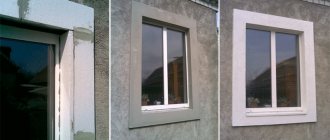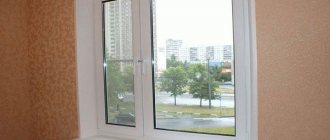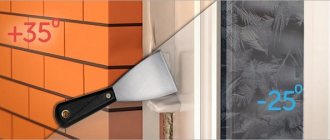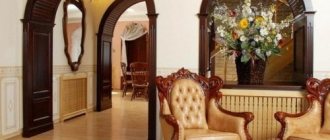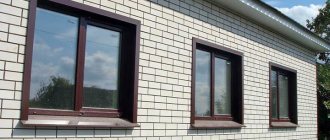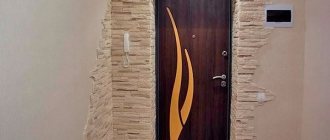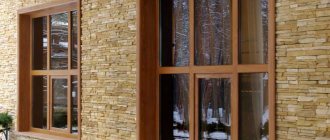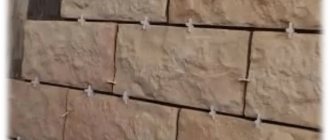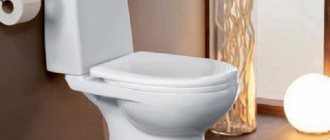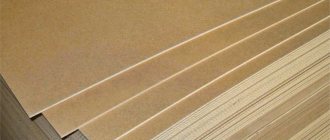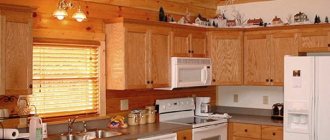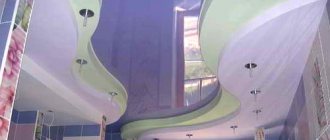Purpose of devices
External metal slopes for plastic windows are designed to protect polyurethane foam from ultraviolet radiation, precipitation, and being carried away by the wind.
If the foam is not covered, in a few years the material will be damaged, cold air will begin to enter the room, and the walls will become damp, increasing the risk of mold. After installation, it is necessary to install slopes on new windows; most often they are also plastic, less often metal. It is better to use metal to improve the interior. It is able to reliably and efficiently isolate the opening from external influences.
Metal slopes for plastic windows must be installed immediately. Many homeowners do not do this, believing that foam will cope without protection. This opinion is incorrect. The main reasons why installation is required immediately:
- Aesthetically, the structure looks unattractive; the façade of the building looks untidy.
- Polyurethane foam will deteriorate under the influence of sun, wind and precipitation.
Foam is not capable of acting as waterproofing; it must be protected from moisture, otherwise moisture will be absorbed and the window will freeze in cold weather. If for some reason the installation of metal slopes is not possible immediately, for example, the building is being renovated, the installed windows with fresh foam must be covered with at least plastic film until the slopes are installed.
Ready-made metal slopes
How to make metal slopes for outside windows
Metal-plastic windows have long become popular and in-demand products for glazing window openings. But in order for the work to be completed, it is necessary to install external slopes, and metal slopes have become the most commonly used options. They protect the polyurethane foam from the adverse effects of the environment and decomposition. This is a prerequisite for completing the work of glazing window slopes. There is no point in delaying this work. This is not only an aesthetic issue, but also a solution for the thermal insulation of window openings.
Table of contents:
- Why are slopes needed?
- How to install metal slopes on windows
- Do-it-yourself metal slopes installation technology
- How to make metal slopes on windows
- Installation of metal slopes on windows
- Installation of metal slopes with your own hands
- Iron slopes for outside windows: advantages and installation
Why are slopes needed?
Window installation is carried out by specialists from the company where the windows were purchased; most often, the cost of the products includes the cost of installation work. But only a few companies include finishing of window openings with slopes in their list of services. All work on installing finishing structures falls on the shoulders of the owner, but he does not have the time or does not have enough funds. As a result, window openings “please” with incompleteness and an unsightly appearance.
Due to the fact that the glazing of window openings is carried out without installing slopes, this matter is postponed until later and gradually fades into the background altogether. In fact, it is worth paying more attention to the issue of equipping windows with slopes, in particular those made of metal. And although there are many options for finishing window openings, metal materials remain the leader at the moment.
Reasons why it is necessary to install slopes as quickly as possible:
- the polyurethane foam used to install the slopes becomes unusable and deteriorates under the influence of unfavorable weather and natural conditions;
- the waterproofing properties of the foam are very low, it instantly absorbs moisture from the environment and deteriorates, and the windows freeze;
- Having high heat and sound insulation abilities, foam that is not covered by slopes loses its capabilities.
If it is not possible to carry out the work of installing slopes, it is imperative that the window structures be carefully covered with plastic film.
A variety of materials are used to make slopes, these can be:
- plastering;
- plastic strips;
- drywall;
- painting surfaces.
All of the listed materials cannot be compared with metal slopes in terms of durability, attractiveness and ease of manufacture. All due to the low quality of materials:
- plaster is a very cheap option, but over time it cracks, gaps appear between the frames, this leads to the appearance of mold and “fogging” of the windows;
- finishing with plasterboard is permissible only inside the building, since the material is afraid of excessive moisture, becomes deformed and no longer performs its intended functions;
- plastic cannot withstand temperature changes and low temperatures, which is why it is also used only in interior decoration; moreover, the material is very unstable to mechanical damage.
In order for your home to have a finished and attractive look, you need to think about the finishing touches. In this case – slopes. It’s these little things that make up not only the visual appeal of a home, but also the quality of life. Indeed, due to the negligence of the owner, the installed structures of window openings can collapse, heat can escape and moisture can enter. Therefore, no savings are made on this process. It is better to install metal slopes, which will fully justify themselves and cover all costs.
How to install metal slopes on windows
Metal slopes for outdoor use are the best option. They are varied:
- copper;
- galvanized;
- iron with galvanized surface;
- aluminum.
The top of the material is sprayed with one of the elements: polyester, pural, plastisol.
This material has a number of advantages:
- it is resistant to corrosion;
- it is possible to use for a long time without additional maintenance or care;
- easy installation and maintenance;
- external attractiveness;
- resistance to adverse weather conditions.
But in addition to the advantages, there are also disadvantages of using metal material, which in some cases can be easily eliminated:
- high cost of material;
- the appearance of loud sounds when rain or hail hits the surface of the structure;
- impossibility of using the material when mounting in arched openings.
The material is available to purchase and use in two colors:
- white;
- brown.
Each of the color shades is used as needed: white is used for snow-white metal-plastic units, dark – for window openings made to look like wood. But for individual orders, different colors are possible. And although the option with metal slopes costs more than those made from other materials, it later pays for itself in durability and ease of installation: you do not need to have additional knowledge. In addition, it is easy to change the color of the material by painting it in any shade.
Do-it-yourself metal slopes installation technology
Metal has long been recognized as the most durable and reliable material for the manufacture of not only slopes, but also a large number of things in everyday life. After installation, they will be able to reliably protect the window opening from the penetration of moisture, wind, and hot air flow. Polyester-coated metal for slopes has become the ideal combination of the reliability of metal and the attractiveness of polyester. As already emphasized, metal edging has a number of advantages that make the material stand out among the variety existing on the market. They do not depend on negative climatic influences, are strong, visually attractive, durable and easy to install and maintain. There is no need for additional maintenance of the material.
Why is it recommended to use metal for slopes?
To protect the polyurethane foam, you can use plaster mixtures, plastic panels, paints and varnishes; if the work is carried out indoors, drywall will do.
Metal slopes for the façade side of a building are most suitable, since this material does not burn, is resistant to any weather conditions, and if stainless steel is used, you do not have to worry about the corrosion process.
The plaster can crack, and when it comes into contact with a PVC frame, condensation often occurs, which harms the walls and the plaster itself, and can cause mold to form. Drywall is afraid of moisture and is destroyed by it, so it can only be used in a dry room; It is unsuitable for the street, as it quickly deforms from precipitation, swells and collapses. Plastic can be used: it is much cheaper than metal, but it is worth remembering that this material does not like temperature changes and becomes more fragile. The mechanical impact of wind can break such panels.
Metal slopes are usually made of galvanized steel: it does not rust and is not afraid of mechanical stress. The material is covered with a special protective layer of polymer on top. It not only preserves steel from the influence of nature, but also allows you to achieve a neat decorative appearance of slopes.
Material for slopes – galvanized steel
Advantages over other materials
There are several types of finishing materials, using which you can give the window opening a complete appearance. These are plaster, drywall, plastic and paint. But in terms of its technical characteristics, none of these materials can compare with metal slopes. When deciding how to make slopes, you need to study the characteristics of finishing materials.
The polymer layer of the steel slope protects the product from rust
When using plaster, you must be prepared for the fact that the plaster layer will crack over time. Moisture getting into the gaps between the window frame and the plaster layer can cause mold to appear.
Drywall as a finishing material for slopes is only suitable for interior work. Even GVLV brand drywall is not able to withstand the direct effects of precipitation. In a short time it will swell, lose its appearance and collapse.
The use of plastic panels for finishing external slopes leads to the fact that in the sun the plastic fades and acquires an unpleasant yellowish tint. And with a sharp drop in air temperature, the plastic becomes brittle and may lose its integrity after minor mechanical stress. Therefore, it is better to use plastic for finishing internal slopes, especially in the kitchen.
Metal slopes are not exposed to weather conditions
The advantages of metal slopes are obvious, since the material for their production is galvanized steel, which is covered with a protective polymer decorative layer at the production stage. This protects products from corrosion and rust.
Advantages and disadvantages of using metal slopes
Window areas are most often decorated with metal slopes, regardless of whether this is done for plastic windows or wooden structures. Therefore, you should carefully consider their advantages:
- The characteristics of the material are such that it can withstand all environmental influences. Any whims will not matter to him. It is also important to consider that the metal does not experience destruction due to mechanical stress. This is especially important in regions with harsh climates and frequent hail.
- Maintenance is not difficult. By choosing this option, you can be sure that the product will serve for many years. It only needs to be occasionally cleaned of accumulated dirt and wiped with a cloth.
Metal slopes do not require special care, you just need to wipe them occasionally
On a note! If you choose a plastic or putty option, you will have to make more efforts to preserve such coatings. PVC quickly loses its original appearance and becomes dirty. Putty (plaster) is subject to destruction, which leads to annual renewal of damaged areas. With metal it is much easier, even if the paint layer peels off, it is easy to restore (this makes it possible to change the appearance).
- The shape of the product creates an excellent three-dimensional frame. It is important to know that, if necessary, any option can be made. Difficulties can arise only with arched structures.
The material has practically no disadvantages. There is only a necessary condition - pasting with sealing tape. It plays the role of sound insulation. If you ignore this feature, then the first rain will make you think about remodeling.
Pros and cons of the material
Despite the fact that external metal slopes are more expensive than other types of finishing, their positive qualities more than make up for this drawback:
- they have a high degree of resistance to corrosion and rust;
Metal slopes are covered with a layer of galvanized steel - they do not lose their technical characteristics over the entire operational period, which is quite long;
- the existing paint layer is durable and does not require updating over time, although, if desired, the slopes for plastic windows can be painted in any color you like;
- resistant to mechanical stress;
- easy to install and maintain;
- have a pleasant external design and look decent on facades lined with different materials;
- not subject to temperature changes and precipitation
- metal slopes can be made in any color scheme.
It is recommended to install noise-absorbing tape along with the slopes
Among the disadvantages, we can note the high cost and the presence of sound effects arising from the fall of drops or hail on their surface . This can be dealt with if you use a special noise-absorbing sealing tape when installing metal slopes.
Another disadvantage of a metal slope is the impossibility of installing it in arched openings.
Advantages
- Thanks to the properties of steel and a special coating, metal window slopes are reliably protected from rust.
- The service life is practically unlimited and exceeds the suitability of analogues by several times.
- Thanks to modern polymers, slopes do not have to be painted.
- Installation of metal slopes is easy and can be done by a beginner.
- Attractive appearance, which allows you to make the facade complete in terms of design.
- Atmospheric phenomena will not cause harm to the material.
- Metal window slopes can be made in various colors, which allows you to match them to any windows. They will suit both standard white or wooden windows and unusual solutions. It is possible to order the desired color and make an original design.
Despite the fact that metal is more expensive than similar options, it will pay for itself, since over time the slopes will not have to be changed. If you get tired of the design, you can always repaint the slopes in the color you want.
Measurement of the structure
Common mistakes when measuring
Before making metal slopes on the windows from the outside, measurements are taken. Accurate measurements are the key to successful cladding. The size of each plot is measured separately. It would be a mistake to take measurements only along the top of the slope, at low tide.
This action leads to problems with the matching sizes of the profile parts; they may turn out to be larger or smaller than necessary, and the defects will need to be eliminated. Measurements are taken with a tape measure, after which the data is entered into a notebook. It is very convenient to use the scheme when you need to cover several windows at once.
Manufacturing nuances
The production of metal protection has been actively developing in our country since Soviet times. The technology is being improved, so each such product is reliable and has a long service life. Today, you can mainly find galvanized slopes, which are made from steel of the same name, resistant to corrosion processes. The inner side of the steel is covered with a layer of soil. A special polymer coating is applied on top of the product to enhance its strength. The structure resembles a metal tile or corrugated sheet: a layer of zinc guarantees protection against rust, and polymer powder paint prevents mechanical damage to the zinc.
The production of slopes occurs only after the completion of the measuring stage, because the width and height of the product must correspond to the opening from the inside and outside. The side segments, as well as the upper and lower parts, are simply cut out from a sheet of metal prepared in advance, focusing on the collected dimensional data. The optimal thickness of the steel sheet is also determined by the parameters of the opening, but also by the required degree of rigidity. Thin metal is more often used - no thicker than 0.55 mm.
Installation of plastic slopes
Finishing the external slopes of plastic windows is the easiest physically task: the reason is the low weight and pliability of the material. It is easy to cut with a regular hacksaw, you can give it the desired shape, the plastic can bend and not break, it can be attached either to self-tapping screws or to various adhesives, ranging from double-sided tape to special glue or polyurethane foam.
You can also attach the slopes to special profiles, but such a warrant will cost more, so ordinary wooden slats are most often used for lathing. There is no need to worry about their safety, since the slope located on them will be able to protect its frame from moisture.
Installation methods
The order in which a metal slope is placed will largely depend on the design requirements and features of the house. External elements are usually mounted in the opening in the following order:
- Using a sharp tool, remove bulging foam pieces and clear the area of construction debris, dust and dirt. All seams are treated with sealant. To do this, take a gun with silicone and walk along the perimeter of the opening. You can proceed to the installation of the slope itself only after the seams have completely dried.
- Now you need to install the window sill. It is placed on the bottom of the opening with foam. To prevent the ebb from bending due to the expansion of the foam, it is pressed tightly for a short time. The height of the ebb is regulated by spacers made of metal or wood. If the ebb is not horizontal, you need to set a level.
- The lower boundary of the intersection of the wall and the frame can be equipped with layers for additional thermal insulation and a diffuser tape, which will reduce noise levels and protect from condensation. After this, the ebb is screwed to the frame with self-tapping screws using fasteners for the corners.
- First, the side parts are fastened with self-tapping screws, taking into account the slope from the inside to the outside, and then the top bar is inserted, filling all the free space between the slopes and the wall with foam. The procedure for attaching all parts is the same: apply foam to the inside of the slopes and the opening. Do not forget to apply sealant to those places where the metal slope comes into contact with the frame. Lean one side of the slope against the pre-attached profile, the other against the wall.
- The sides are installed vertically, attracting them with screws, and the upper part is already mounted taking them into account, secured with self-tapping screws. Each joint area is again treated with sealant.
External slopes for PVC windows
In the last article, I talked about how to seal the gaps between a plastic window and the wall of a house on the street side. This stage has been completed, the foam is sealed and protected from fading in the sun.
The next step is plastic external slopes. They are beautiful and will also be additional protection for the window mount, which is a rather unreliable and drafty place in the entire structure.
Material:
- U-profiles (cost pennies) for panels (8 mm, in my opinion)
- Plastic panels (used surplus left over from finishing the loggia)
- Polyurethane foam
- Sealants
- Primer
Tools:
- Jigsaw
- Foam gun (if the can was taken without a spout)
- Caulking gun
- A clear head and relatively straight arms
- Tape measure/ruler/marker
Preparation
The slopes will cover the end part of the outer wall, so all three sides (top, right, left) must be carefully measured in order to cut a trapezoid from the panels.
Note!
You need to start from the top slope. It is the most fragile, due to the fact that it is forced to be suspended
The side ones will then hold it.
I got lazy, cut it anyhow, then smoothed the edges on the sharpening machine. It’s better to cut straight away, less waste, dirt and work. If you doubt the accuracy of your measurements, you can use cardboard.
After cutting all three parts, I packed them into U-profiles, which I put on the panels and cut them very evenly... with a grinder =). One touch - and the profile part is cut perfectly evenly, without chips or burrs.
In general, the method is not for everybody. Some people cut with a hacksaw, some with a knife, some with scissors. As I already said, I started the installation from the top of the slope, along the rough side of which I covered it with foam.
Installation
Next, with all the profiles attached to the panel, we firmly lean our slope against the previously primed and cleaned surface (plaster/slab/brick should not crumble). And so that it (the upper slope) does not fall, it needs to be thoroughly supported (I used old baseboards).
At this point, I removed the P-profile from the outer edge due to the foam that had come out (more precisely, I removed it myself and put it on later, after I had cleaned off the foam).
The tape pieces need to be prepared in advance. And just in case, some clear tape too. If the paint does not stick well to the wall, it can be reinforced with transparent (packaging). The foam dries very quickly, but I left it for a day, as recommended by the foam manufacturer.
You need to press the upper slope (and the rest too) against the wall (opening) very tightly. It’s the same problem with the side slopes: we pack them into profiles, glue them and press them hard. A lot depends on the condition of the opening. I came across a crooked one, the brick protrudes at the top, so gluing it was more difficult.
Note!
And let me remind you again: before installing external slopes on PVC windows, be sure to think about how you will fix the panels, and also prepare clean rags and acetone (cleaning liquid) in case of smeared foam.
The last flaws must be cleaned out immediately, before a yellow stain appears, which can be left on the plastic by polyurethane foam. And the gluing surface must be smooth, without holes, crumbs and protrusions.
I used glossy panels and they look very nice. But for internal slopes I recommend matte (or sandwich) ones. The tape must be peeled off the next day to prevent the glue from sticking in the sun.
Sealing of slopes
Sealing of slopes
No matter how tightly the slope with the U-profile is pressed against the window frame, there are still gaps. As I read, people seal them with whatever they can: liquid plastic, sealants and even putty.
My gaps turned out to be narrow, and I coated them with acrylic sealant. It is washable and can be painted with a small brush to ensure reliability.
In the last photo you can see that the upper slope is covered (on top of the gap between the slab and the slope) with polyurethane sealant.
He definitely doesn’t care about the frost, water and sun. It wasn't necessary to do this, but just in case.
Note
I did not use the F-profile due to the unevenness of the wall. I was afraid of water flowing under it and the growth of black mold.
Polyurethane and acrylic sealants, as well as liquid plastic and similar pastes must be applied very carefully: without proper experience, it is easy to ruin the working surface. So first practice on something less valuable than new plastic windows
Installation tool
Before installing metal slopes on windows with your own hands, prepare the necessary materials and tools for the job:
- Screwdriver with bits.
- Measuring tape and corner.
- Scissors for cutting metal.
- Hammer.
- Stationery knife.
- Spatula.
- Construction pistol.
The fastest way to install metal slopes is in new houses where there were no wooden windows. Otherwise, you need to prepare a place to work. It should be noted that the external slope should be done quickly, when the installed window frame can begin installation. Otherwise, the polyurethane foam begins to deteriorate, cracks appear, and in winter the window opening may freeze.
Basic functions of metal
What external metal slopes on windows look like.
Metal slopes for PVC windows are not just used for beauty; this design has several main functions:
- The window opening after finishing will be finished and visually beautiful. An arched metal window opening has a finished decorative look. There are standard design options and others that differ in design and color.
- Slopes made of metal profiles for windows protect joints and seams from environmental influences, for example, from wind, sun and precipitation. The seams will not collapse, and the window will last a long time.
- Due to the external metal slopes, excellent sealing is obtained; additional thermal insulation can be installed. When installing slopes without facing material, they will quickly collapse, cracks will appear, and the metal-plastic window frame itself will begin to let cold into the house.
As you can see, installing metal slopes on windows allows you to achieve not only a beautiful view, but also protects the house and the window from damage.
Installation of metal slopes
Installing metal slopes on windows with your own hands is a simple procedure, but it requires care and attention. To work you will need a minimum set of tools:
- Screwdriver with a set of bits.
- Tape measure and square.
- Metal scissors.
- Hammer.
- Construction knife (stationery version).
- Spatula (if additional preparation is required).
- Construction pistol.
Tools required to install a metal slope
On a note! The installation process is fastest when the work is carried out in a new house where there were no wooden windows. Otherwise, it is necessary to provide a set of preparatory measures.
It must be taken into account that external work is carried out as quickly as possible. You cannot wait a long period of time after installing window frames. Many people mistakenly believe that work can be delayed during the summer. But the result of such inaction is destroyed polyurethane foam and microscopic cracks that have absorbed a lot of moisture.
Work on the installation of external slopes must be carried out immediately after installing window structures
Measurement of the structure
Common mistakes when measuring
Before making metal slopes on windows from the outside, measurements are taken. Accurate measurements are the key to successful cladding. The size of each plot is measured separately. It would be a mistake to take measurements only along the top of the slope, at low tide.
This action leads to problems with the matching sizes of the profile parts; they may turn out to be larger or smaller than necessary, and the defects will need to be eliminated. Measurements are taken with a tape measure, after which the data is entered into a notebook. It is very convenient to use the scheme when you need to cover several windows at once.
Stage two - preparation
Careful preparation is necessary for window openings whose adjacent walls are made of brick or concrete slabs. Such structures are subject to numerous falls and are covered with cracks. The following manipulations are performed:
- The polyurethane foam is cut off. It is removed flush with the window frame. This is done using a construction knife.
- The general condition of all surfaces is assessed. If required, cracks and holes are covered with putty.
- The formation of voids between the installed elements and the base must not be allowed.
- The surface and seams are additionally treated with sealant. It is best to soak concrete and brick surfaces with an antiseptic, this will prevent the appearance of mold.
It is necessary to give some time for the applied materials to dry.
Before installing metal slopes, it is necessary to restore the integrity of the coating
Step 3: Finishing the seams
It is very important that good thermal insulation of the room is achieved, and for this it is necessary to thoroughly treat all seams with sealant. So we pick up a gun with silicone and carefully apply it around the perimeter of the entire window. After drying, we do a visual inspection for the presence of untreated areas; there should not be any.
Stage three - installation
The dimensions are transferred to metal strips that have the necessary bends. Each element is cut using metal scissors. The technology is as follows:
- Finishing the slopes begins at low tide. This part is cut to the size of the window frame or less by one centimeter. The outer part is cut to the specified size of the opening, taking into account the allowance for the wall. The side parts are made with an allowance of one centimeter - they will need to be folded. The structure should be tilted away from the window.
- The ebb is installed in its place. It turns out that it fits the surface well, with its side walls extending into the vertical areas. It is screwed to the frame using self-tapping screws.
- Next, the side racks are installed. They are placed vertically, they must cover the curved sections of the ebb. Attached with screws.
- The top part is inserted last. It is adjusted to the installed side strips and aligned with the outer corners. Secured with self-tapping screws.
- Now you can apply sealant, which should reliably cover all adjacent areas of this structure.
Installation of metal slopes begins with the installation of low tide
It must be remembered that the sealing tape is pre-glued.
Thus, a beautiful and reliable cladding appears on the windows, which will play not only a decorative role, but also protect the surface from destruction.
Preparing for installation
Preparation for installation
Careful preparation must always be made, no matter what the house is made of, brick, timber or concrete panels. Step-by-step instructions for preparation are as follows:
- The mounting foam is removed; it should be flush with the window frame. The work is carried out using a stationery knife.
- Next, you need to assess the condition of the walls and surfaces, and if necessary, eliminate all cracks, cracks or cracks with regular putty.
- Voids are not allowed between the base and the iron element.
- The joints and the surface itself are additionally treated with sealant. If the walls are made of brick or concrete, then before installing the finishing material on the slope, you should soak everything with an antiseptic, which will prevent mold from appearing.
All mixtures used must dry out, when the defects have been eliminated, then installation must begin.
Why is it necessary to cover the polyurethane foam?
Despite the obvious advantages of installing external metal slopes, many homeowners delay this process for various reasons:
- Not enough time;
- On the advice of the craftsmen, paint over the foam;
- Insufficient financial resources;
- There is not enough experience to do it yourself, and inviting specialists is expensive.
But you need to know that polyurethane foam, if it is not protected, undergoes the following processes:
- Destruction due to exposure to sunlight.
- It loses its properties as a thermal and waterproofing material - saturation with moisture even by 5% reduces its ability to retain the internal heat of the house by half.
Therefore, mold and rot may appear on wooden windows, and metal-plastic structures will begin to freeze. The result of all this will be the replacement of windows and additional expenditure of money.
Finishing external slopes with metal with a polymer decorative layer has many positive aspects. The original color of the metal remains for several decades. Thanks to the existing protective polymer layer, the slope finishing elements do not rust and do not require periodic painting. They are easy to clean and also easy to install. Window-wall connections already sealed with mounting foam or sealing tape are reliably protected from external influences, as a result of which these materials retain their thermal insulation properties.
Slope function
Finishing windows on the outside with metal slopes performs decorative and protective functions. By installing slopes on windows with your own hands, you can close the installation seam and thereby protect it from exposure to precipitation and direct sunlight .
Metal slopes perform a protective and decorative role
Polyurethane foam, used to seal the joint between the frame and the window opening, is a porous, vapor-permeable substance that allows moisture from the room to pass through it. As a result, moisture and condensation settle on the surface of the window slopes, which leads to the formation of mold and destruction of the integrity of the structure. Moisture from the street can penetrate through the mounting seam and cause fogging and freezing of the window in winter.
By installing metal slopes on windows, you don’t have to worry about these troubles, since metal is a strong, durable and easy-to-maintain material with high performance indicators.
Dimensions and design
Since slopes are made individually, measuring each window or doorway, the parameters of the product can be very different. The same applies to the level of complexity of the design. However, the metal slope is always solid and exactly fits the measurements, so high protection of the seams from water and sun is guaranteed.
The following types of slopes may have an unusual design:
- For ventilated facades or siding facades. In this case, the slopes will have protruding elements and shelves for fastening.
- For a brick facade. The slope will have a Z-shape.
Slopes for different facade windows, for example, can have a width of 2-60 cm. The length varies from 10 to 300 cm. Standard lengths are 125 cm, 200 cm and 300 cm. The thickness of the metal varies from 0.4 to 0.8 mm.
Slopes for ventilated facades
In ventilated facade systems using various types of cladding, a slope with several fastening shelves and protruding elements is generally installed.
| Rice. 1. General view | Rice. 2. Dimensions |
Using a mounting strip, the metal slope is attached to the guides of the subsystem, under the cladding. The frame is made in such a way that after installation the offset ranges from 2-4 cm.
Slope for a brick facade
The simplest version is the Z-shape. Fastening is done through a fastening shelf or special inserts to the window structure; the side areas are filled with insulation or foam.
| Rice. 3. Design | Rice. 4. Dimensions |
Metal slope for siding facade
For siding facades, it is possible to use the same metal slopes as for ventilated facades, or a specialized version with hidden fastening.
| Rice. 5. Design | Rice. 6. Dimensions |
Purpose
Metal external slopes perform several important functions:
- The iron platband for windows gives the appearance of the opening an attractive, neat appearance. The steel slope is often made in the same color as the profile of the window structure - white or brown (for wood-laminated profiles). However, if the customer wishes, the panels can be painted in any color according to the RAL catalog.
The customer can choose any color of the slopes from the RAL catalog - Protection of the assembly seam from moisture and exposure to natural phenomena in the form of precipitation, wind and temperature changes.
- Protection of the slope surface from dampness, mold formation and destruction. External metal slopes reliably seal the wall surface and increase its heat-insulating qualities.
Metal window trim should be installed immediately after the windows are installed to prevent moisture from being absorbed by the foam . If this cannot be done in the near future due to work on finishing the facade, then the installation seams on the windows can be temporarily covered with polyethylene.
Instructions for finishing with metal sheets
The process of installing metal slopes is not complicated, but it requires care and precision. To properly insulate a room from the street, it is practiced to place thermal insulation under the sheets.
The work is performed in the following sequence.
- The window opening is measured, and the sheets of metal are cut into strips. The strip for the lower part of the opening is cut with a small margin to form a water drain.
Measuring and adjusting the tide
This is what the edge of the low tide should look like
- The first part to be installed is the lower part - the ebb. It is screwed to the frame and has small overhangs on the side sections of the window opening. It is important that the ebb is diverted from the window.
- Side stripes are installed. They are pressed tightly against the surface of the opening and cover the curved parts of the ebb.
- At the final stage, the top strip is installed.
- To improve the insulating characteristics of the structure, sealant is applied to the joints of the strips.
Features of installation work
The finishing of window slopes from the outside with metal is carried out sequentially in 5 stages. This includes measuring, preparing the base, working with seams, installing ebb and flow and slopes. Let's look at each step in more detail.
Metering
The dimensions of the window opening are not standardized. Therefore, taking measurements for slope elements is an important step. Here the internal and external width with height and depth are taken into account. It should be taken into account that the ebb with the top and side parts may differ. To work, you will need a verified measuring device so that what you expect does not differ from the result obtained.
Preparatory stage
First you need to remove excess polyurethane foam after it has completely dried.
Trimming excess foam Source ytimg.com
To do this you will need a construction knife. The cut is made in the same plane as the window frame profile. Next, you need to remove all debris, protruding areas, remnants of mixtures and adhesive solutions from the surface of the opening.
Metal slopes are characterized by durability, so it is worth additionally performing preventive treatment of the opening. Exposed reinforcement is hidden with cement plaster. They do the same with cracks, crevices and deep chips. The wood is impregnated with a fire retardant to reduce its ability to ignite. The surface is also treated with antifungal agents.
Mounting clearance
Foamed filler has low thermal conductivity. The thin layer, due to its porous structure, partially allows air flow to pass through, which causes heat loss. This can be eliminated by using sealing materials for outdoor use. These can be compositions based on latex binder. Many craftsmen additionally apply a small layer of plaster with preliminary priming of the surface.
Silicone sealant for windows and glass Source stroy-ars.ru
Metal ebbs and slopes for windows and plinths
Metal ebbs for plinths and windows, door and window slopes. Manufacturing of moldings and metal profiles to order. Current price, delivery and installation.
Depending on the place of application, window sills and base sills are distinguished.
Window sills
Window sills are installed at the bottom of the window opening. Slopes are included with the ebb tides. They are mounted on the top and sides of the window opening.
These profiles protect the space between the main wall and the curtain wall (basement or vinyl siding) from water. They also give the facade a finished look and decorate it.
Ebb tides for the base
Base flashings are mounted above the base, for example, between vinyl and base siding. They protect the base and foundation from rainwater and close the gap between the panels and the base. Also, metal flashings are placed above the protruding elements of the facade - to protect them from rainwater.
Sometimes the building's base does not clearly stand out or is missing as a separate element. Then, to protect the foundation from water flowing down the wall, flashings are placed on the foundation. They differ from the base flashing in their smaller width. After all, the ebb on the foundation is not installed over a protruding plinth, but is simply attached to the wall.
| window sills and slopes | basement flashings | tides on the foundation |
Material for production
Metal ebbs and slopes are made of galvanized steel sheet with a polymer coating. The color most often chosen is white - then the window openings stand out better on the facade. White metal slopes and ebbs retain their whiteness longer than plastic ones. They are easier to clean - even abrasive dust is easier to remove from metal than from plastic. They are also stronger and hold their shape better.
But the good thing about metal ebb and flow is that their color can be matched to the color of the roof. After all, they are made from the same sheet as roofing materials. Both the strength and durability of metal ebb and flow are the same as that of metal tiles or corrugated sheets.
Types of external slopes for plastic windows
If you do not install external slopes immediately, but postpone the process for an indefinite period, then soon you will have to repair or replace windows.
Finishing external slopes is an important and final stage of window installation, and such a process is best trusted only to highly qualified specialists. Then the installed windows will delight you with their appearance for many years.
Plastic
The characteristics of the plastic material are transferred to products made from it. This means that plastic slopes have all the qualities that are inherent in the plastic itself. They are durable, wear-resistant, moisture-resistant, and are not afraid of temperature changes.
Few citizens have the equipment at home that “high-rise workers” use, so you will most likely have to hire a team of construction workers to complete the exterior finishing.
Installation of external slopes is carried out in stages:
Preparation of the surface and plastic plates:
- All dirt and dust are wiped away from the outside of the window. You should also cut off any foam protruding onto the frame. Places where there is no foam cannot be seen; on the contrary, they should be foamed.
- Preparatory work also includes the preparation of the slopes themselves. Plastic external slopes are cut to size from standard wide plates.
- Such plates can be found at a hardware store. They need to be cut to size, the end edges need to be cleaned a little so that there are no “torn” parts.
- Cut the plastic slowly. The material may be fragile. If you cut it intensively, small chips may fly off, which can injure you.
- Installation of the starting, U-shaped profile. It is screwed to the edges of the plastic frame on three sides. The end part of the slope will be embedded in this profile.
- Installation of an F-shaped profile around a window opening. It should be installed so that the profile groove is a mirror image of the U-shaped profile. The second part of the slope will be inserted into it.
- Now the next step is actually finishing the external slopes of the windows, that is, installing a plastic plate. It can be immediately mounted in the window opening.
But in order to provide additional insulation of the slope, a layer of insulation, for example, cotton wool, should be laid under the plastic.
Siding construction
How to make external slopes with siding? In fact, siding is the same plastic, only it has a corrugated shape. It consists of a set of different types of profiles and finishing plates.
- Before installing siding, all external surfaces of the building must be lathed.
- Then the siding ventilated facade and external slopes are attached to the sheathing. Siding plates have fastening holes in the upper part through which the material is secured to the sheathing.
- Each subsequent plate is superimposed on the previous one, hiding the fastening “seam”. As a result, it turns out that there is no trace of fastenings anywhere on the wall.
- External finishing of slopes of plastic windows with siding involves carrying out similar operations as when installing plastic slopes (the difference is in the form of the profiles themselves).
- Siding slopes have a special design; various bends and ebbs are used to secure them, allowing you to “assemble a system” of slopes.
Making plaster
Plastering external slopes is the simplest and most common type of finishing. For facade work you need to use facade putty. The operating procedure is as follows:
- First you need to cut off excess foam and remove debris. Then the surface should be primed in order to protect it from the formation of fungus and mold.
- Next, you should dilute the solution according to the instructions. Then the mixture is applied to the slope and leveled with a spatula.
- For work, it is convenient to use two spatulas: one for applying the solution to the wall, the second for puttying and leveling the surface.
- Then the surface must be given time to dry.
- It should be painted. For work, you can use any facade paint.
Helpful advice!
If necessary, the paint can be tinted with dye.
External slopes made of metal
They are used for finishing windows in buildings, the facade of which is decorated with a metal profile, or rather with metal profile sheets (the finish looks like the surface of a container).
Slopes are made of metal with a polymer coating (colored), or from galvanized sheets. The slopes are secured to the surface with screws or rivets. Color coating and galvanization protect the metal from corrosion; it does not need to be painted later.
https://youtube.com/watch?v=NNL6vQsSC18
Low tide installation
The length of the ebb is greater than the width of the opening, this is done on purpose. The width of the window opening is transferred to the metal ebb panel with an allowance on the sides. Cut off, allowances are cut so that “ears” in the shape of a trapezoid and a triangle are formed at the edges, which will cover the corner of the opening. The trapezoids are bent upward.
After the casting is ready, it must be applied to the bottom of the opening. Before final fastening, a noise-absorbing tape is laid. It's easy to install. A piece of the required length is cut from the skein. Remove the protective paper from the adhesive side and apply the tape. The ends are brought to the side slopes. The tape has a high degree of adhesion to various surfaces (concrete, metal, etc.), the main thing is that there is no dust or debris on them. The tape cannot be painted or plastered, as it will lose its working properties.
Correct installation relative to the surface is checked by level. If the panel is warped, it is necessary to remove the warp with available materials. Any metal or wooden spacers are suitable for height adjustment.
Drill holes in the ebb, base. Fasten with self-tapping screws and dowels.
What are slopes and why are they needed?
Slopes are the walls of a window opening. That part of the opening that is located in the apartment forms internal slopes, and from the street - external ones. Finishing of slopes must be done after installing the window or during its operation.
Read more about choosing window slopes and their installation in the article.
The main purpose of slopes is a smooth transition from the window structure to the wall, thereby increasing the tightness of the window and improving its appearance. The window is of great technical and decorative importance for any room. It is the main source of cold in winter, as well as a passageway for street noise, so additional sealing of the window in the form of slopes will not be superfluous. And an additional bonus is that installing slopes will add elegance to the window.
Sequence of work
Installation of metal slopes on windows involves carrying out measuring work. The width and height of the product will correspond to the internal and external parameters of the opening. The manufacture of the top, bottom and side metal elements is carried out by cutting them from a prepared metal sheet in accordance with the measurements obtained.
Scheme for trimming a metal slope
Scheme for trimming the lower metal ebb
Scheme for trimming the upper metal ebb
At the second stage of work, the installation of a low tide takes place, the horizontal position of which is controlled by the building level. The lower junction of the wall and the window frame is equipped with a special heat-insulating material and diffusion tape for noise reduction and moisture protection.
First you need to install the tide
When attaching the ebb, mounting foam is applied to the window opening and to the ebb from the inside. To prevent it from bending due to the expansion of the foam, it is pressed tightly for a while. After the ebb is fixed, the installation of metal slopes begins.
Before installing metal slopes, it is necessary to treat the places where they will come into contact with the window frame with sealant.
Metal slopes are secured with polyurethane foam
First, the side elements are installed, maintaining the required slope from the inside to the outside. The upper and lower parts are adjusted using a knife depending on the level of inclination.
The side elements must be installed in a vertical position and tightened with screws. The upper part is adjusted to the side elements. It is aligned with the outer corners and secured with self-tapping screws.
At the final stage, all contact areas are treated with sealant.
When installing slopes on a façade made of corrugated sheets, use horizontal lintels
If the façade of the house is covered with corrugated sheets, it is necessary to use horizontal lintels when finishing window openings. These are side shelves made of corrugated sheets, which are attached to the wall on one side and to a metal profile on the other. Steel trims give the façade completeness.
Metal
Let's look at how to make metal slopes on plastic windows.
This option is the most convenient. They are much easier to install than the plasterboard option. The disadvantage of such slopes is the high cost of materials and the fact that such slopes are not suitable for every wall design.
Metal slopes are made mainly in wooden houses. Wood is not stable, so plasterboard and plaster cladding will not work. Over a fairly short period of time, such slopes will crack.
Metal for such slopes is used no thicker than 1 mm; if you take thicker metal, it will be problematic to cut it with metal scissors. But using a grinder to cut parts will not be very convenient.
The technology for installing such slopes does not differ significantly from the installation of plastic panels. The sheets used for metal slopes are coated with powder paint. This provides them with durability, protection from sunlight, and protection from rust.
The sheets are sold ready-made; you just need to cut them to the required dimensions and secure them with self-tapping screws. They should be mounted on the sheathing, since fastening them to the wall will be problematic. The lathing is made of wooden planks up to 30mm thick. The material for slopes is used in different colors, so it is worth choosing screws to match the color of the slopes so as not to spoil their appearance.
We invite you to watch a video about how to install metal external slopes:
Basic rules for carrying out work
Do-it-yourself window siding will be done slightly differently depending on the design of the window opening. As a rule, windows in our houses are made according to several standards:
- According to European standards, slopes are less than 19 cm. Then the size of the window strip will be standard - up to 22 cm. It is very easy to attach with your own hands, even by non-professionals - for this they use a finishing profile into which the strip is inserted. The finishing profile can even be replaced with a J-profile and bevel, which will help reduce overall costs.
- According to Russian standards, slopes are more than 19 cm. For such windows, you will need a J-profile placed near the frame. An outer corner is mounted around the perimeter of the window, into which the siding panels are inserted.
- Windows without a slope - a casing must be installed, and then siding is attached to it.
- An arched window requires the use of a flexible J-profile. A regular one will do, but it will need to be cut a little - in those places where the shape of the window bends.
To attach siding around window openings, it is recommended to use standard metal profiles.
The process of designing a window opening begins with installing a starting strip. After this, serial installation is carried out, with each row carefully adjusted to the grooves of the previously installed ones. If a standard size plank cannot be installed in the slope, the sheet is cut to the required dimensions.
Installation diagram of window profiles for siding finishing
After the entire area of the slopes has been sheathed, additional accessories are installed. However, these elements are completely optional - all their functions are performed by standard siding.
Work is being carried out in a special way to cover the arched window opening. Here you will need a special elastic profile. It is secured with nails or self-tapping screws around the perimeter of the window opening. Next, sheathing is carried out - always observing a 15-cm step. Where the siding touches the supporting profile, the strongest possible fastening is ensured - no gaps are left for expansion in arched windows.
If the emphasis is placed on window openings in the design of the facade, then the finishing is done with platbands 6.2 cm wide. If the design of the slopes implies “invisibility,” then preference is given to a narrow J-profile. However, you can independently choose the option that suits you best in terms of decor and price.
COLORS OF METAL SCOPE
The cost of manufacturing products made of galvanized steel is calculated based on the size, as well as the chosen color. Products in standard colors according to the RAL catalog have a lower cost. Below are the standard colors.
| RAL 1014 | RAL 1015 | RAL 1018 | RAL 3003 | RAL 3005 |
| RAL 3009 | RAL 3011 | RAL 5002 | RAL 5005 | RAL 5021 |
| RAL 6002 | RAL 6005 | RAL 6029 | RAL 7004 | RAL 7005 |
| RAL 8017 | RAL 9002 | RAL 9003 | RAL 9006 |
Products whose color is not included in the list of standard colors are painted separately. Our company paints our products with powder paint, which has the highest protective properties.
Tools and materials
Puttying slopes will require the necessary tools and available materials. For a quality installation you will need the following list of tools:
- Small spatula for application.
- Medium spatula for smoothing.
- The building level is of impressive size.
- Bucket for preparing the solution.
- Spatulas should have a wide and narrow blade.
- To mix the solution you will need a construction mixer and a bucket.
- To ensure smooth slopes, get a level and plumb line.
- If drywall is involved in the repair, you will need a screwdriver and small screws.
- You will need starting and finishing putty for windows. They are available in paste or powder form. The second one will have to be diluted first.
- Tile adhesive and ceramic tiles, wallpaper or paint.
IMPORTANT! To ensure clear edges, you can use a perforated corner. Last but not least on the list is primer.
Instructions on how to install external structures with your own hands
Now we will tell you step by step how to install metal slopes on plastic or other windows, and what needs to be done for this. After all the preparatory work and measurements, the process is divided into several stages:
- If the slopes are cut out yourself, then all measurements taken earlier are transferred to a sheet of metal, and the contours are cut out with special scissors.
- Preparing the opening for installation work:
- Trim off excess foam with a paint knife.
- Clean the opening from dust and dirt, treat it with an antiseptic to prevent the appearance of mold and mildew.
- If necessary, seal all cracks with plaster (find out how to seal seams and cracks when installing slopes with plaster and other methods here).
- Next, all seams are covered with sealant.
- The most critical stage is the installation of ebb and corners. How to install and secure them:
- The first step is to install the lower part - the ebb. It is leveled using a level gauge. To prevent the metal from making a strong noise when it rains, you should place noise-insulating material (noise-absorbing tape or a thin layer of polyurethane foam) under the part. Important: If the mounting foam, which is applied to the lower part of the ebb and a little on the base of the window frame, begins to lift the structure, you must evenly press down the ebb with something heavy along its entire length. Afterwards the part is screwed to the window frame with self-tapping screws.
- The side slopes are attached next. It should be remembered that the upper and lower parts have a slope from the inner edge to the outer, so the edges of the part are cut in accordance with the angle of contact with the ebb and the corners of the opening. At the same time, competent measurements and a neat cut will prevent the formation of cracks, and all slopes will fall into place. After precise installation, the side parts are attached to the window frame with self-tapping screws and a press washer.
- The last to be installed is the external cladding element, which is also secured with self-tapping screws. For better thermal insulation, all cracks are filled with polyurethane foam (find out in this article how to properly work with polyurethane foam when installing window slopes, and what to look for when choosing foam).
- Careful inspection of all joints and cracks, which are additionally filled with sealant (how and with what to seal the seams after installing the slopes?).
We invite you to watch a video on how to install external metal slopes with your own hands:
Installing metal slopes with your own hands is not particularly difficult, the main thing is accuracy in measurements and careful installation of this facade element, which, despite its relatively high cost, can last for decades.
Wet finishing method
This cladding variation is the most traditional and economical option. The simplicity and simplicity of this method makes it possible to plaster and paint the slopes yourself. To finish the surface, you need to prepare a dry mixture based on cement or gypsum. It should be noted that this type of work differs in the duration of the manipulations performed. And also the “fur coat” needs to be dyed periodically.
Before plastering external walls, they should be prepared. Preparation consists of cleaning from dirt, defects, and excess foam. To protect the window, it is recommended to cover the structure with masking tape. Plastering slopes should be done in stages:
- The first step is to install the beacons at a distance of up to 5 cm from the window frame; fixation is done with nails.
- The thickness of the plaster layer should cover the window by 1 cm. The generally accepted thickening is 2 cm. The corners should be aligned with a square.
- After making sure that the opening is clean, it is possible to apply a primer. Priming is intended to improve the adhesion of the plaster to the base.
Puttying external slopes
- The cement-gypsum mortar should be applied over the beacons and smoothed with a spatula. Manipulations must be done from the bottom up.
- After the first layer has dried, the beacons should be removed, and the locations should be covered and leveled.
- 1 layer of plaster should not exceed 7 mm. It should be taken into account that it is correct to apply a new layer of plaster only on the dried previous layer. Also, don't forget about angular alignment.
- After the plaster has set, the wooden frame is removed, and the defects are covered and smoothed.
- You can slightly moisten the coating with a wet rag and remove any imperfections using a grater.
- After thorough drying, whitewash or paint is applied.
The window must be closed during work. Because if the mixture penetrates into the fittings, functionality may be impaired. An obvious negative property of the finishing method is the failure to combine the cement mortar with the PVC profile. This contributes to the appearance of a hole between the slope and the frame base. Therefore, the resulting gaps should be sealed with silicone-based sealant.
Photo gallery of finished works
Important! By choosing to finish the outside of windows with metal slopes, the work is easier, and the surface itself will last longer. Even if the paint peels off, the slope coating is easily restored.
The shape of the metal will allow you to create a three-dimensional window opening for any type of window. Difficulties when working with your own hands appear only when creating an arch.
Sources
- https://oknanagoda.com/okna/naruzhnye-metallicheskie-otkosy-na-okn.html
- https://otdelkagid.ru/vnutrennyaya/okna/naruzhnye-otkosy-iz-metalla.html
- https://balashiha.facade.ws/metallicheskie-otkosy.html
- https://ingener-pto.ru/2019/12/12/kak-otdelat-okno-snaruzhi-metallom/
- https://otdelkasam.ru/vnutrennyaya/okna/naruzhnye-metallicheskie-otkosy-na-oknah.html
- https://remoskop.ru/metallicheskie-otkosy-okna-ustanovka-svoimi-rukami.html
- https://mezhdveri.ru/29338-podrobnaya-instrukcziya-po-ustanovke-metallicheskih-otkosov-na-okna-ot-podgotovki-do-montazha-s-foto.html
- https://remoskop.ru/naruzhnyie-otkosyi-metall-ustanovka.html
- https://kvadratstroy.ru/metallicheskie-otkosy-naruzhnyie-otsinkovannye
- https://balkon4life.ru/osteklenie/okna/naruzhnue-otkosu-dlya-plastikovyx-okon/.html
- https://www.navesfasad.ru/remont/ustanovka-metalliceskih-otkosov-na-okna.html
- https://okcomfort.com/okna/otkosy/svoimi-rukami-naruzhnye.html
- https://okcomfort.com/okna/otkosy/metallicheskie-svoimi-rukami.html
Preparatory work
Preparing for the exterior finishing of the window opening
The question of how to finish window slopes from the outside is significant, but first of all you should study the basics of preparatory work. Since exterior finishing is a required procedure for all methods. Preparatory work includes a number of points:
- All protruding elements are removed from the coating.
- Checking the reliability of the surface, eliminating defects.
- Slots and cracks should be treated with a primer.
- After this, the surface should be coated with putty.
- Exterior finishing requires additional sealing. The sealant must be applied to the entire surface of the installation joint and part of the adjacent wall.
READ DIY mineral wool sandwich panels
How to properly trim a window with metal slopes in 36 minutes
Finish options
External slopes for plastic windows are finished with a material that matches the walls and window structures from a design and technical point of view.
Plaster
This is a budget finishing option, well suited for wooden window frames. To implement it, a special dry composition is purchased. The top layer of plaster can be covered with whitewash or paint that can withstand sun and moisture well. Even a person who does not have special construction skills can make such window decor. But from time to time the plaster coating has to be renewed.
Plastic
Installation of such slopes is suitable for windows made of metal-plastic. They are easy to install yourself and do not require pre-leveling. After work, as a rule, there is no construction waste left. The product is suitable for any type of insulating material and does not lose its qualities from exposure to moisture or sub-zero temperatures.
PVC panels can be mounted on windows - they are unpretentious in operation and have good sound and heat insulation properties.
Sandwich-type products consist of two layers of hard plastic, between which is sandwiched a thick piece of insulating material (usually polyurethane foam). They are available in a wide range of colors, allowing you to choose the right option for your home.
Metal
Finishing the outside of windows with metal slopes is beneficial because these products can withstand different types of environmental influences, including mechanical ones. This is especially important in areas where hail regularly occurs.
A polymer coating is applied to the products, which protects them from rust. Such cladding lasts a long time, maintaining an attractive appearance for decades, which is no different from plastic and plaster.
It is easy to care for metal products: it is enough to wipe them from dirt and dust from time to time.
During installation you will need to apply sealing tape.
Natural or artificial stone
Decorating window openings from the outside with stone will require large investments, but this is compensated by the durability and noble appearance of the finished structure. Since the material is quite heavy, it loads the base and walls. Before deciding to use it, you need to make sure that the foundation will support the additional weight.
Materials for slopes
A variety of materials are used to finish external slopes on windows. The most popular cladding:
- plaster;
- plastic;
- expanded polystyrene;
- metal;
- vinyl siding;
- drywall;
- natural stone;
- sandwich panels.
Each of these options has certain advantages and disadvantages. Therefore, before making a final decision, you need to get acquainted with their characteristics.
